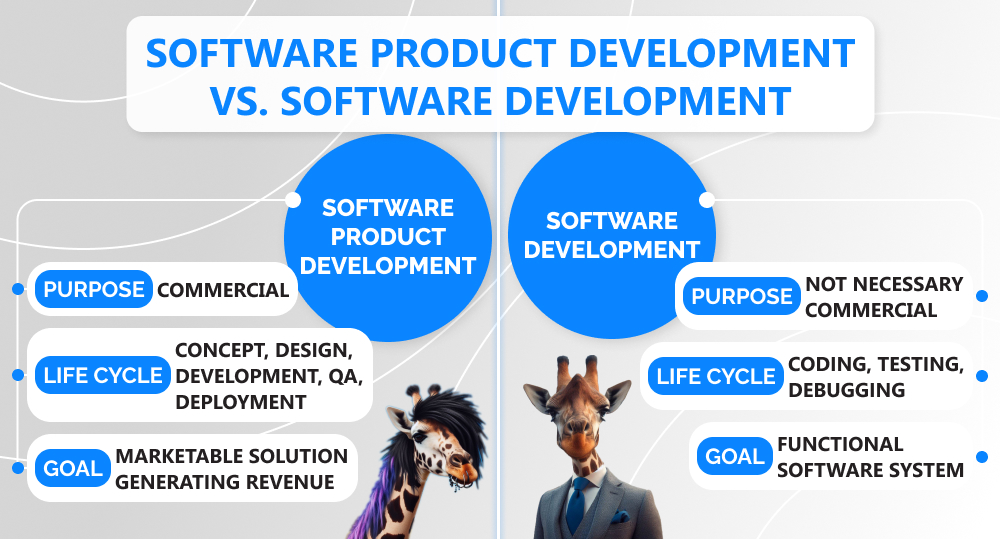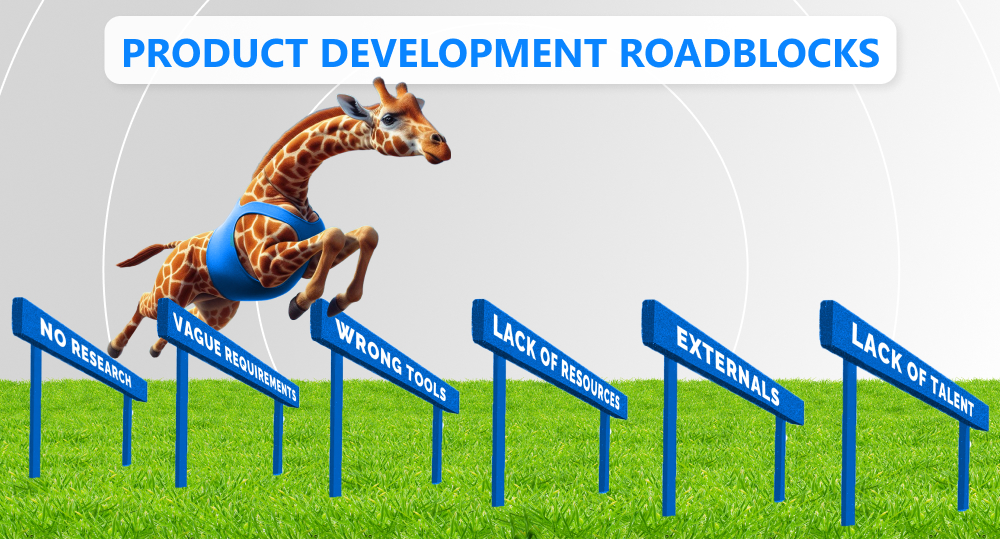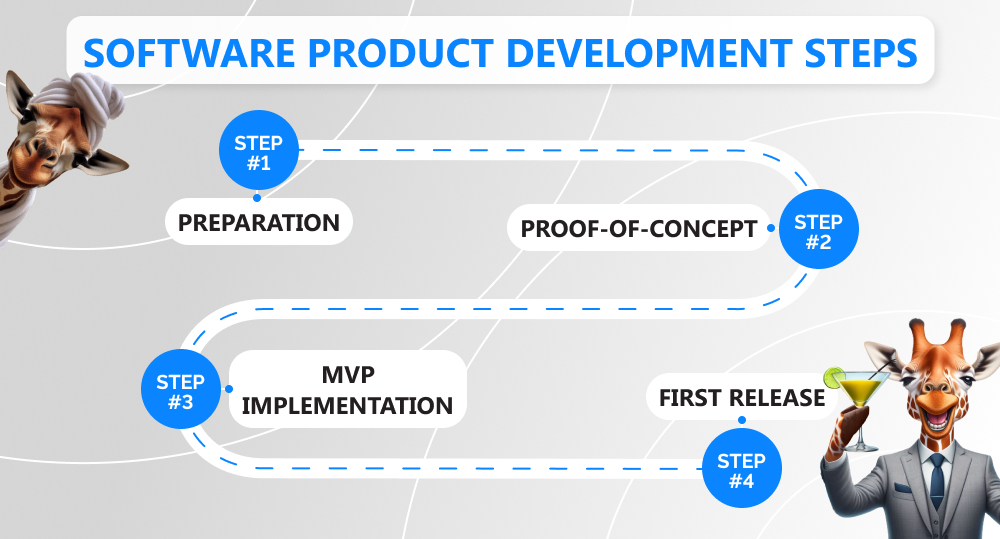Do you know how many projects fail before the software product development process is even completed? According to the Gitnux report, the number is a staggering 70%! That's like five friends each attempting to launch their own product: one will succeed, another has a 50/50 chance, the remaining three will probably go bust before the release of the beta version. Blame it on costs or a poorly chosen tech stack.
What if we told you there was an opportunity to increase your project's chances of success? This guide will unveil all the secrets for a successful product development strategy. Let's jump right in!
written by:
Alexey Krutikov
Project Manager, PMP
Contents
What Is Software Product Development?
Like any creature on our planet, living or non-living, software products go through their life cycle. During this time, they progress through stages from birth — introduction — to decline and eventual death. This cycle provides a chance for developed software products to thrive and gain a myriad of satisfied users. But there is also a possibility of sudden disappearance from the digital world. The reasons for such a grievous outcome may vary:
- A feeble, untested idea at the core of the software;
- A poor technology stack;
- An inexperienced development team;
- Insufficient marketing;
- A lack of ongoing support and bug fixes.
Sometimes a product gains success and popularity, only to be overshadowed by a similar solution that causes people to consign it to oblivion. Then it ages and leaves the market. Is there a way to foresee such a scenario?
An effective product development process stands as the most critical factor for software success. A truly innovative, one-of-a-kind solution requires careful planning and proper implementation. That's why our team has prepared this guide for you. Let's find out what the product development process is, what stages it comprises, and what aspects you should pay special attention to.
Spot the Difference: Software Product Development vs. Software Development
Although there are two related terms, software development and software product development, there is a clear distinction between the two.
Software product development refers to the process of building an application, generally for commercial purposes. It includes the entire product life cycle, from the initial concept and design to development, quality assurance, and deployment. The primary goal of this process is to develop a marketable solution that fulfills customer needs and generates revenue for the company.
Software development is a broader term that encompasses the creation of a software solution, regardless of whether it is for commercial purposes or not. This process involves coding, system testing, and debugging to build various applications.
The key difference between software development and software product development lies in their focus and business goals. While software development targets the creation of functional software systems, product development places extra emphasis on marketability, creating value for the company, and increasing customer loyalty and satisfaction.
Roadblocks for the Software Development Process
Henry Ford once said, “Obstacles are those frightful things you see when you take your eyes off your goal”. In any business, therefore, you should be mindful of the hurdles you may encounter on the way. Not to dread dealing with them, but to take every possible step to prevent them. What roadblocks demand your utmost attention on the challenging path of software product development?
Lack of Pre-development Research
Neglecting to research your target audience, competitors, and industry trends is fraught with serious consequences. Without it, developers may end up building a product that fails to meet the expectations of either the business or its users. This results in wasted time and resources, which can ultimately lead to the failure of the software development project. Don't fall into the mistake that 23% of organizations make by trying to stay ahead without a clear market research strategy.
Vague Project Requirements
Insufficient pre-development research can lead to another issue — inadequate presentation of project requirements. Without an accurate product vision, it's challenging to develop a solution that meets customer expectations. Ambiguous requirements can stem from multiple reasons: poor communication between stakeholders, incomplete project briefs, or lack of clarity about the desired outcomes.
Improperly Chosen Technologies
Software development processes require careful consideration of the programming language, framework, and architecture. If your team won’t conduct market research to evaluate available technical options and their suitability for the project, they may inadvertently choose incompatible or ineffective tools. Such a lapse can cause increased development time, reduced software performance, and challenges in scaling and maintaining the product in the long run.
Inadequate Resource Allocation
Insufficient investment of resources, including time, money, or skilled personnel, is a prevalent challenge during the product development process. What happens when resources are scarce? Production delays, quality degradation, missed opportunities, weak product potential, and other frustrating issues that are absolutely out of place when you are on a deadline, striving to promptly release a first-rate product.
External Dependencies
These dependencies refer to factors outside your direct control that can affect the progress and success of your product development efforts. Common examples include:
- Third-party integrations;
- Reliance on outside vendors or suppliers;
- Regulatory or legal requirements.
For instance, you may rely on another company to provide a vital component for your solution. If they experience delays or production issues, it can significantly impede your own timelines.
Tech Talent Shortage
With the swift pace of technological advancements, the world sees skyrocketed demand for professionals well-versed in all the latest innovations. As McKinsey & Company states in its study, such shortage has caused “the war for talent”. It has led to escalating salaries and benefits packages, making it harder for small companies or startups with limited resources to stand ground.
Even the education system is struggling to keep up with such rapid progress. Traditional educational institutions often fail to timely adapt their curricula to meet industry demands, resulting in a gap between the graduates’ skills and those sought by employers.
However, leading companies are seeking to address this issue by developing the capabilities of their existing teams and enhancing their skills. Finding a team that can quickly adapt and acquire the necessary skills is a challenging but significant goal.
What You Can’t Go Without: a Checklist
Once we've expounded the reasons, restraining software product development processes, let's go through a list of essentials for ensuring a 99% success rate for your solution.
Preliminary Market Research
A product thrives as long as people use it. But simply launching it and waiting for users is not the best strategy. To gauge its appeal, you should test your idea before building the product. Undertaking research is ideal for this purpose. By using surveys, focus groups, and data analysis, you'll get insights into your target audience's minds. This will help create user personas and understand the pain points that your solution should address.
Getting to know your competitors is equally valuable. By examining the current market landscape and identifying key rivals, you'll get one step ahead:
- Assess their strengths and weaknesses;
- Uncover existing gaps and opportunities;
- Develop unique selling propositions to stand out in the market.
Carefully Selected Methodology
When the whole world is constantly rushing forward, development teams should keep calm and clear-headed to prevent any harm to software projects. The key to this mental sobriety is a proper methodology, which paves the way for seamless development. Below are the most widely used software development methodologies:
Agile
Agile is an iterative and flexible approach to software development and project management, prioritizing adaptability and collaboration. It emphasizes delivering small functional pieces of software in short cycles called iterations or sprints. The Agile methodology aims to respond to changes quickly, ensuring that the end product aligns with the customer’s needs.
Agile project management methodologies — Scrum, Kanban, and Extreme Programming (XP) — provide specific frameworks and practices to implement these principles. Scrum, for example, is one of the most widely used Agile frameworks. It divides the development process into fixed-length iterations called sprints, focused on delivering a potentially shippable product at the end of each iteration.
Waterfall
It’s a traditional software development methodology, sequential and rigid in nature. It involves a linear progression through phases like requirements gathering, design, development, testing, and deployment. While Waterfall may work well for projects with clearly defined requirements and few modifications, it can be less flexible when facing changes in user needs or market shifts.
Innovation-Friendly Development Team
Technical expertise, rich experience, and high professionalism are three primary components of any development team. These attributes are so must-have that only the laziest person would fail to mention them alongside the name of their company. However, to select truly outstanding software engineers, you must also consider their creativity and commitment to innovation. Professionals with these skills aren't bound by the limitations of the past. They explore non-conventional ways to improve processes, develop salient features, and deliver advanced solutions that conquer the market. Think of Netflix, which reshaped the movie industry. Or Spotify with its smart music recommendation algorithms. Or Airbnb. Or Slack. Examples galore. Would you like to be another role model for others?
Well-Thought-Out Tech Stack
By technology stack we mean the entire set of programming languages, frameworks, libraries, tools, and databases the team uses during the software product development cycle. It forms the foundation of a business's technical potential, dramatically affecting its scalability and overall prosperity. Particularly if you use highly adaptable digital components: cloud platforms, AI systems, microservices architecture, and open-source APIs.
What components comprise the backbone of a powerful tech stack?
- Robust programming languages: Java/Python/C#/JavaScript;
- Frameworks: Angular/React/Django/Laravel;
- Database management systems: PostgreSQL/MySQL/Oracle/MongoDB;
- Cloud services: AWS/Microsoft Azure/Google Cloud Storage;
- Version control systems: Git/CVS/SVN.
Data-Driven Product Management
Proper data management is absolutely crucial for any software product. With it, navigating towards the right direction becomes as easy as following a map. By opening the navigator, you can get comprehensive information, easily locate where you are, and find the optimal route. What is it like on the project?
Data-driven product management involves the collection, storage, organization, and analysis of information throughout the software development lifecycle. It may include:
- Identifying data sources;
- Determining collection methods;
- Designing databases;
- Ensuring data security and privacy.
1-2-3-4: Software Product Development Steps
Let's proceed to the core of our guide, which has brought you to this page — software product development stages. The whole process is intricate and demands meticulous planning and execution. But broken down into steps, everything turns out to be much simpler than it seems.
Step #1. Preparation
When embarking on the software product development process, take the time to conduct comprehensive business analysis and software architecture planning. This step is vital to understand the project goals, requirements, and limitations. As a result, you should get a precise software product development plan (and a template for future endeavors).
Important! Before taking this step, you should define the software product development team structure and ensure all required specialists are in place.
1) Business Analysis
At this development stage, your team should gain a complete understanding of the business requirements and elaborate a software product development strategy.
What's the main goal?
- Identify the pain points, challenges, and opportunities for the product;
- Ensure the solution is tailored to both the business and its customers.
What's the outcome?
The software development team will establish clear business goals and project requirements, defining the key features of the product.
2) Market Analysis
During this stage, companies get an in-depth view of the current situation and target market: key competitors, major trends, and potential customers. The insights gained at this point guide the development process and increase the chances of success.
What will the team do?
- Collaborate with stakeholders;
- Scrutinize existing business processes;
- Conduct interviews;
- Assess the market landscape and target audience.
3) Software Architecture
After defining the business strategy and requirements, the product architecture takes center stage. It illustrates how different components interact with each other during the software product development process to achieve the desired functionality. It also determines the technologies, frameworks, and platforms that will be used to build the product.
What will the team do?
- Define the system modules, interfaces, and data flow;
- Determine the technology stack and platform to build your software;
- Consider security, performance, and integration capabilities.
What's the main goal?
Ensure scalability, flexibility, and maintainability of the product.
What's the result?
A modular and scalable software system that can adapt to future changes and enhancements.
Step #2. Proof-of-Concept Implementation
Once your product has a clear concept and strategy, the next step is to execute a proof of concept. This step involves building a miniature version of the solution to conduct an idea feasibility analysis and validate its potential.
What will your development team do?
- Identify the key functionality to include in the POC;
- Develop a prototype with core functionality, external dependencies, and basic user interfaces;
- Test and validate the prototype.
What will the marketing specialists do?
- Validate the product relevance in the market;
- Gather feedback from stakeholders to monitor the critical software product development metrics and identify necessary changes;
- Conduct a feasibility study to determine the viability and profitability of the solution;
- Refine the concept based on early feedback and test results;
- Decide whether to release the product to the public.
What's the primary objective?
Create a working prototype that demonstrates the concept’s viability and potential to meet the identified requirements.
What's the result?
The end prototype will serve as the basis for subsequent software product development phases, such as MVP development and testing. It will provide insights about the technical feasibility, usability, and market potential of the product concept, helping to guide the full-scale development phase.
Step #3. MVP Implementation
If the product has proven its relevance, at this stage your team moves on to the actual development of the solution that users will see among the market offers. This is when the benefits of an Agile software product development process become evident, since along with the MVP, it aims to minimize waste, increase speed, and streamline workflows.
What will the team do?
- Create a development plan that outlines tasks, timelines, and resources required;
- Identify development team members and allocate responsibilities;
- Translate design specifications into actual lines of code;
- Involve QA engineers to conduct manual or automated testing to promptly identify and fix bugs;
- Follow an iterative development approach: code, gather feedback, make necessary adjustments, repeat;
- Release a minimum viable product to a limited audience.
What will the marketing specialists do?
- Identify target customer segments;
- Collect feedback and data on the product usability, desirability, and viability;
- Plan promotional campaigns;
- Develop a comprehensive go-to-market strategy for the first release.
What's the main goal?
- Validate the product idea and test the market demand for the solution;
- Prepare for the next stages in the software development life cycle.
What's the result?
The release of a minimal, ready-to-launch version of the product, containing only the essential features that define its value proposition.
Step #4. First Release
As we move along the software product development roadmap, we've reached a key milestone of effort — the official Launchday! This is the culmination of hard work and dedication, and the beginning of your software’s journey into the hands of users.
1) Project Management
What will the software developers do?
- Before release, they ensure software quality, stable performance, and fix major bugs and issues;
- Prepare user documentation and tutorials;
- Develop a launch plan;
- Deploy and release your software product.
What's the main goal?
To introduce the solution to the public and set the stage for further improvements and updates.
What's the result?
Your product becomes available to users for the first time. A software launch can take two forms:
- A beta version that allows users to test the application and leave feedback;
- A full release that makes the software available for purchase or download.
2) Product Management
The first release of your solution requires coordinated efforts from product managers and various stakeholders to ensure a smooth and successful launch.
What will the marketing team do?
- Reach out to potential audience through social media, email campaigns, and content marketing to draw their attention;
- Establish relevant key performance indicators (KPIs) to measure the product success;
- Analyze data, gather customer feedback, and iterate on the product based on insights gained from post-launch analytics.
What’s the primary goal?
To monitor KPIs and create a continuous feedback loop. This allows the product to evolve and mature based on real-world usage and customer demands.
What to Expect in Post-Development?
The software product development life cycle doesn't end with the launch. To keep your product competitive and gain adherents, your team shouldn't miss out on regular updates and enhancements. These may entail new features, functional improvements, or performance optimizations. The development team should collaborate with product management to prioritize and schedule these updates based on user feedback and market trends.
What else to look out for:
- Analyzing user feedback;
- Bug fixes, patches, and software upgrades;
- Continuous testing and quality assurance;
- Performance monitoring;
- Customer support and maintenance;
- Open and transparent communication with users.
A Secret Component of the Software Product Development Lifecycle
It is the word “agility” or simply “agile”. The software product development life cycle, as we’ve already mentioned, is a complex process with many moving parts. The methodology you choose to guide your team down this path determines half of the future success of your solution.
To illustrate our point, let’s take a look at the Agile model’s masterful approach to solving common software product development challenges.
Problem
Solution
Miscommunication and lack of interaction between team members
An Agile team is cross-functional, comprising individuals from various disciplines who collaborate to promote improved communication, knowledge sharing, and a sense of collective ownership.
Changing requirements and priorities
The Agile methodology saves time by presenting changes as new opportunities, rather than an extra week of work. An iterative approach enables teams to quickly adapt to ever-changing business needs, market trends, and tech advancements.
Lack of teamwork
Frameworks like Scrum and Kanban offer a system to manage tasks, encourage teamwork, and establish transparency. They promote regular communication through daily meetings, sprint planning, and retrospective sessions.
No customer engagement
The Agile approach cultivates a customer-centric model that involves clients in the software product development process flow. After each sprint, they provide feedback that shapes the product.
That’s why Qulix team always adheres to the Agile development process.
Why Outsourcing Drives the World Out of Mind
You have a groundbreaking product idea and have studied the entire process of development inside and out, but a lack of resources may prevent you from implementing it. What can you do in such a case? It makes sense to outsource custom software product development services.
Some may argue that in-house specialists offer more advantages than remote software developers based overseas. They will cite greater control, cultural compatibility, and better understanding among the reasons. Then why do 92% of G2000 companies decide to outsource their needs, including the software product development process? The report by ISG perfectly demonstrates that this practice has become a key driver of global business.
What's the best choice for you? Check out the official statistics of companies choosing an outsourcing or in-house team to provide high-quality custom software development services.
Outsourcing Team
In-House Team
70% of B2B companies in the UK hand off their key business operations to outsourcers (YouGov). The main challenges of external teams are: high costs (23%), poor communication (21%), missed deadlines (14%). (Oberlo)
72% of organizations have an in-house marketing agency. The main challenges of internal teams are: lack of energy (63%), attracting top talent (44%), and difficulty with applying key marketing processes (37%). (MarketingDive)
Picking the ideal software provider to implement your solution is as challenging as selecting a language and framework for product development. Here you will find our essential guide to outsourcing to study this option in detail. The decision is solely yours, but it will determine the result. Choose wisely.
Bottom Line
Whether you decide to walk the product development path alone, with your in-house team, or with a software development partner, this journey of a thousand miles begins with a single step. However, it’s crucial to bring along a winning idea, a dedicated development team, appropriate methodology, advanced tools, and a sound strategy. Too many components? Perhaps. Better to have lots of components that help a product get up to speed quickly than numerous bugs that push it to the margins among rivals.
Are questions about the software product development process still swirling around in your head like a bee swarm? Contact us, and we'll work together to answer all of them (even the seemingly silly ones).

Contacts
Feel free to get in touch with us! Use this contact form for an ASAP response.
Call us at +44 151 528 8015
E-mail us at request@qulix.com










